Family : Crocodylidae
Subfamily : Crocodylinae

Text © DrSc Giuliano Russini – Biologist Zoologist

English translation by Mario Beltramini
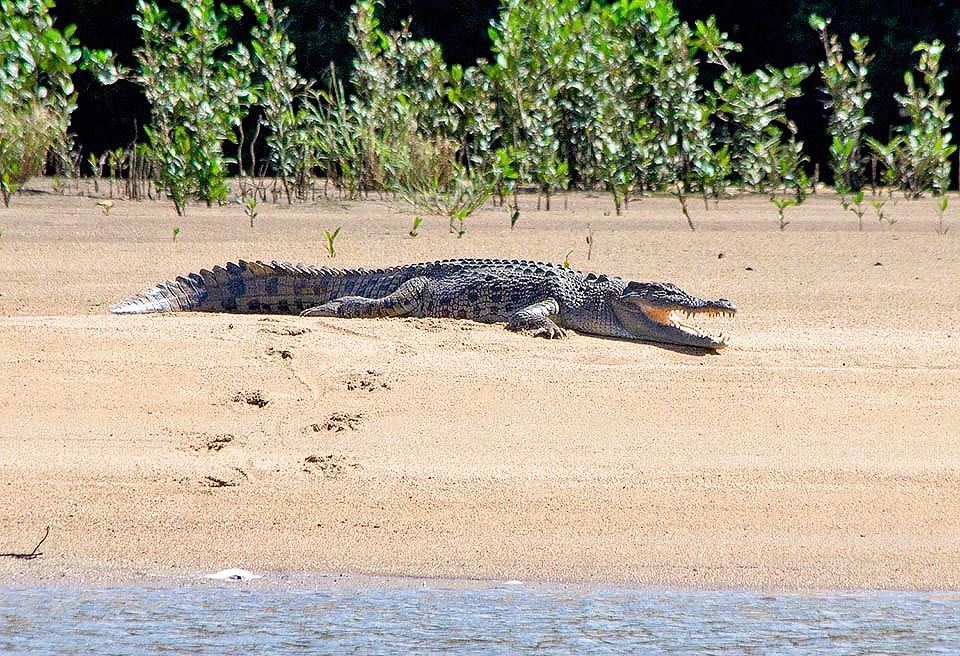
A Saltwater crocodile (Crocodylus porosus) digesting its big meal in the sun in its preferred habitat, close to the mangroves © Giorgio Venturini
For what the size is concerned, only the Gharial (Gavialis gangeticus) may compete with him, and, for the aggressiveness, the famous Nile crocodile (Crocodylus niloticus as a matter of fact, the saltwater as well as the Nile crocodile are, not only “Apex-predators” (that is, on the top of the food chain in the areas where they do live), but also man-eaters, like the lions and the tigers for what the carnivorous mammals are concerned. This appalling and enormous loricate is afferent to the order of the Crocodiles (Crocodylia), family of the Crocodylids (Crocodylidae), subfamily Crocodylines (Crocodylinae), and genus Crocodile (Crocodylus).
The lemma “crocodylus”, already discussed in the other texts of the members of the same genus, comes from the ancient Greek and means “worm-shaped pebble”, the term “porosus” means “full of callosities”, comes from the ancient Greek “porosis” (callosity) and from the Latin term “osus”, that is, “full of”, referred to the rugged surface of the adults’ muzzle.
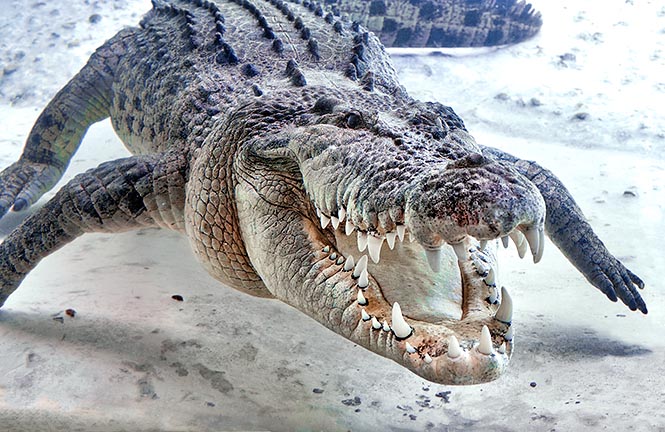
It's an apex predator, i.e. when adult has no rivals. Better not to be met in water © Giuseppe Mazza
Some Australian and Fijian biologists have proposed the existence of a subspecies of the saltwater crocodile, called Crocodylus porosus minikanna, but not accepted by most of the herpetological biologists, including those of the International Code for Zoological Nomenclature (ICZN).
In side some crocodile farms they have observed very interesting phenomena of hybridization between the Saltwater crocodile (Crocodylus porosus) and the Siamese crocodile (Crocodylus siamensis).
This may mean a certain phylogenetic closeness between these two species and also that they can come from a common progenitor. The produced progeny is sterile; therefore such hybrids are detrimental, weakening them, of the pure blood lines of the two species.
The CITES inserts this species in the appendix I, but in Papua New Guinea and Australia, where it is placed into the appendix II; the IUCN declares its status as at “low risk”, LRIc (Low Risk, for now at least).
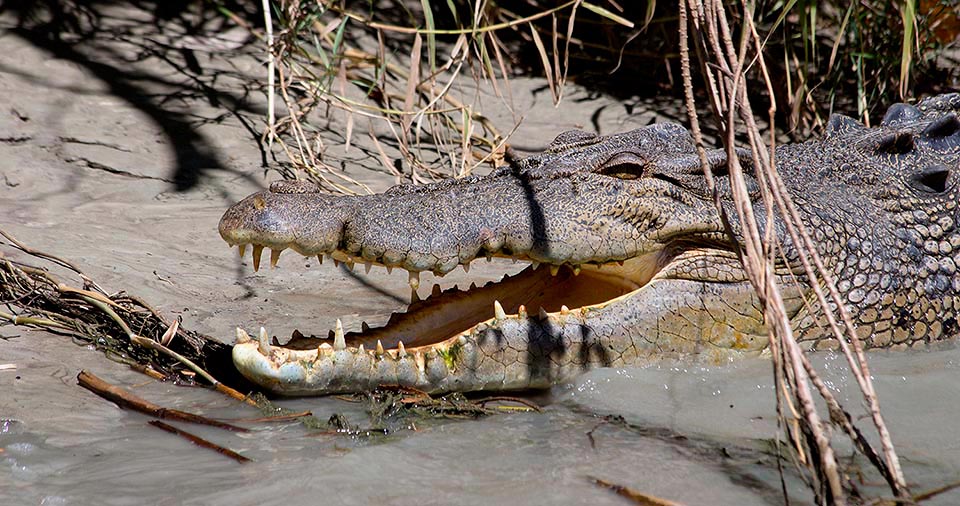
Observes, camouflaged between light and shadow, then attacks ruthless. During World War II, in 1945 on Ramtree, Burma, island, about 1000 Japanese troops, to escape Brits, entered a swampy zone, ignoring that it was infested by these crocodiles that have massacred them © Giorgio Venturini
Biologists calculate that presently the population is of 200.000-300.000 specimens; in the Ecology-Habitat section we shall indicate all the possible environmental conditions which modulate its population density.
Zoogeography
Even if its geographic distribution is limited to the Indo-Pacific area (Indo-Malayan, Indochinese) and Oceanic (Australia), seen the geographic fragmentation of the area, it is found in numerous locations.
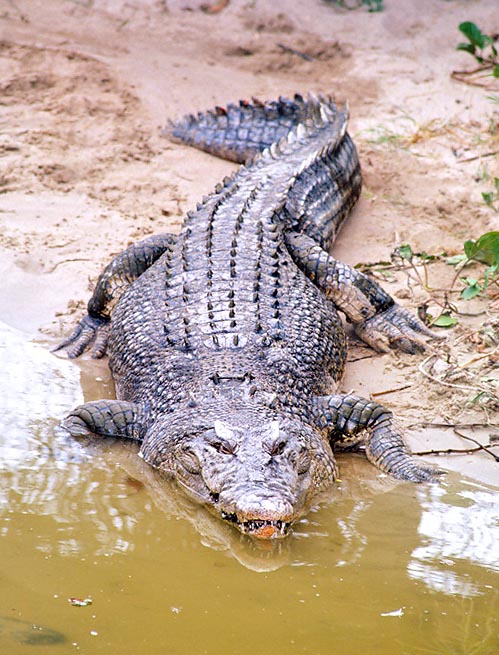
Doesn't hesitate to attack man, this was an alibi for hunting © Giuseppe Mazza
Furthermore, due to its great ability in swimming in the open seas also for several kilometres, from which comes one of its common names, single specimens have been found also along the coasts of Japan and of the Fiji Islands, as well as along the coasts of the Indian Ocean islands.
In some specimens, the biologists have observed, on the scales of the back, the presence of cirriped crustaceans, such as the Striped barnacles (Balanus amphitrite), the same covering the hulls of the boats or the skin of various species of whales, permanent inhabitants of the sea.
Seen that the fixation of these crustaceans needs long times, they are the proof that the Crocodylus porosus can really cover thousands of kilometres at sea and spend there very long times, without being affected at all.
Historically, until the thirties of the last century, it was present also in the Seychelles Islands, where, nowadays, it is completely extinct.
Ecology-Habitat
As its common name of saltwater crocodile implies, this loricate tolerates much well the waters with high salinity, sea ones as well as of the mouths or the deltas of the rivers, in saltwater lagoons, in the Mangrove areas and in the coastal ones, where they have been quite often sighted. However, they can be also found in freshwater systems: rivers, lakes, swamps or in the Billabongs (called also Oxbow lakes in Australian English), small Australian lakes, U-shaped, forming in the meanders of major fluvial streams. The presence in a water stream or in another depends on the age of the animal, its movements between the dry season and the rainy one on the social status it holds.
The young are bred in freshwater streams or in hydro graphic basins, whilst the sub adults are forced to abandon these areas by a dominant adult, who uses them as “nurseries”; the same fate happens also for a subordinate. Sub adults as well as subordinates (the two categories do often coincide), are often obliged to move in saltwater streams or hydro graphic basins in marginal areas.
Along the coastal marine areas, these reptilians swim looking for a river where to establish their territory. Some can also install themselves counter current in water streams, called “upstream”, where the waters are more salted. If a sub adult or a subordinate is stubborn in not leaving the area where a dominant is present, it is not unusual that it is killed.
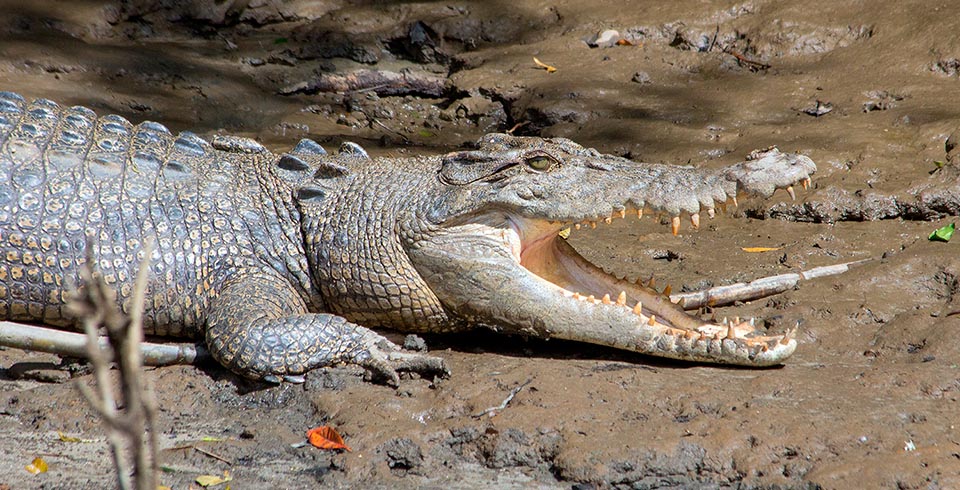
It's now protected especially in Australia where are more than 100.000 specimens in suitable ambients where they are not a problem for the natives and for local fauna © Giorgio Venturini
The saltwater crocodile is an extremely dangerous man-eater, and numerous attacks to the human being have been reported by this huge loricate, which, if they have not killed the ill-ventured, have by sure crippled him very severely and in a permanent way.
This has contributed to creating a climate of hostility and terror against many species of crocodiles. On the one hand, this is understandable, but in many instances this is exaggerated. The human being has a definite “vice of presumption”: he often thinks to be indestructible, and his arrogant carelessness makes him prey not only of the saltwater crocodiles, but also of lions and tigers, not to talk about the fatal accidents caused by animals which, by sure, do not predate the humans, such as rhinos, elephants, poisonous snakes, etc.
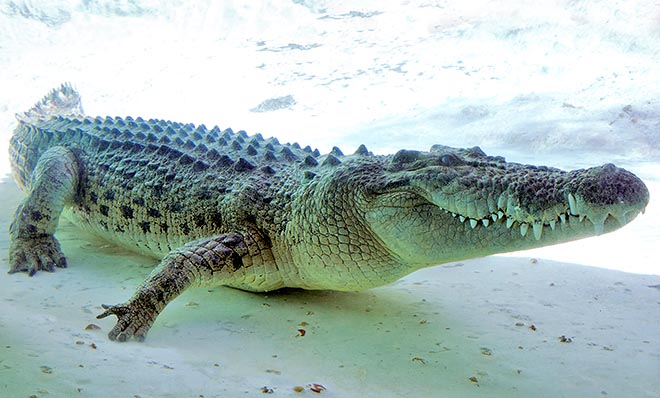
Like gharial it can maybe reach 7 m, but as average is 5-6 m, weighing one ton © Giuseppe Mazza
But this negativity motivated by such incidents, renders difficult, in the meantime, to enable the development of conservation programmes towards species which the non-biologists consider as “useless” because dangerous, as if the biologist who would wish to activate a project of conservation of the saltwater crocodile, would in reality activate a project of conservation of the “anthrax bacillus” or of the nowadays extinct “smallpox virus”.
In the case then of the Crocodylus porosus, the absence of ventral osteoderms and the remarkable size of the belly which allow to get huge quantities of skin easy to tan, has in the past generated a remarkable venatorial pressure, leading this animal to the limit of the extinction; on the other hand, the common persons saw in the hunting of this animal also a way to get rid of it.
This uncontrolled hunting between the 1945 and the 1970, has caused the death of thousands of specimens of saltwater crocodile, and in many areas, among which Australia, it has risked the extinction.
Even though nowadays the hunting of this reptile is unlawful, the poaching still does exist, and this, adding to the pollution phenomena of its biotopes and to the agricultural conversion of entire areas, still creates remarkable environmental pressures which may cause risk to the population. We have to add to this the inefficiency of some governments in being able to enact laws to protect the saltwater crocodile.
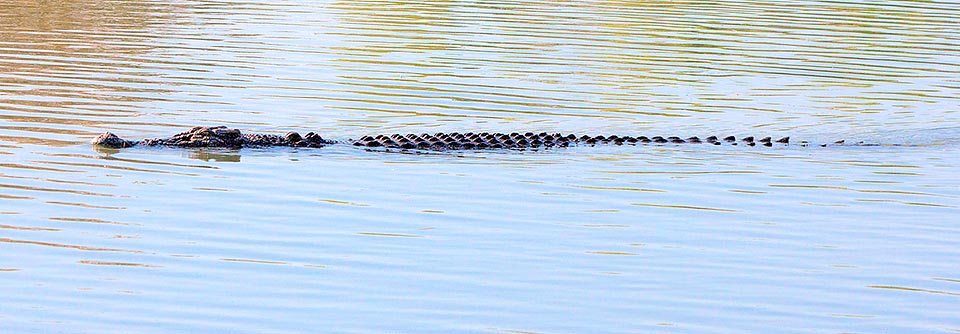
Emerged, looks like a drifting log, but with a tail blow can jump in a flash out of water to bite the grazing preys that come to drink © Giorgio Venturini
In the meantime, they try also to show the necessity of creating suitable natural areas where to be able to allow him to live and reproduce and that it is not a species to be killed at all cost.
The destiny of this uneasy work has fallen to Australia not only because it has one of the most developed and devoted to the nature governments in the world, but also because in Australia do live the most numerous populations of saltwater crocodile. The biologists calculate that there are about 100.000-150.000 saltwater crocodiles, distributed especially among Western Australia, Queensland and the Northern Territories, which host the most populated nuclei.
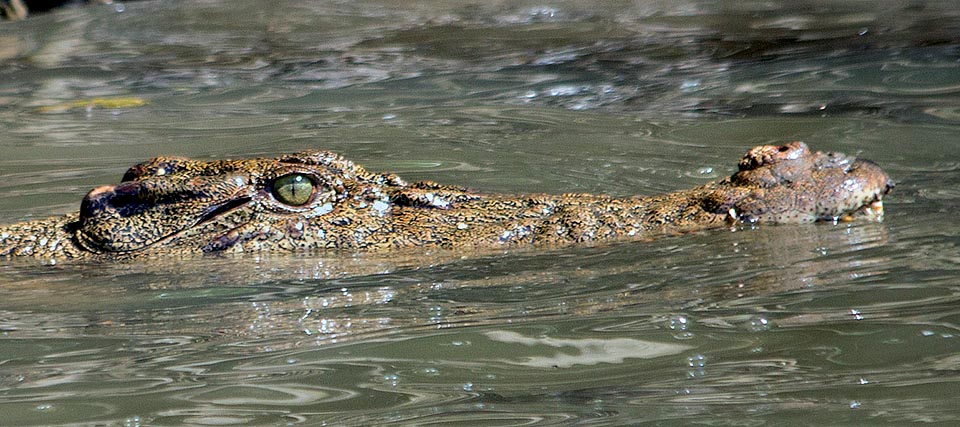
The nostrils, with valves, and the ears having a mobile pinna, indicate an aquatic and terrestrial life in the meantime © Giorgio Venturini
Furthermore, in the Northern Territories, where for about 26 years the hunting to the saltwater crocodile was legal, they have created some safari areas. Here the aborigines are employed as guides by those wishing to practice the sport hunting to the crocodile, and, in order not to affect the natural stock, the animals come from the crocodile farms.
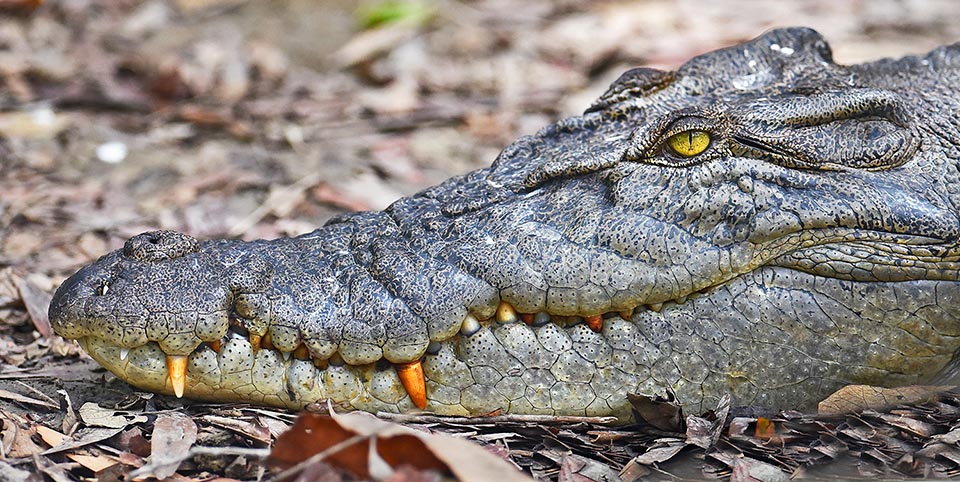
The eyes are obviously placed up, at water level, not to be seen when swimming in surface, and has 64-68 teeth © Gianfranco Colombo
In addition to Australia, conservation projects of the species have been activated in various nations. For instance, in India, in the Bhitarkanika National Park in Orissa, which is a “hotspot” for the biodiversity (as hotspots are defined by the biologists those geographic areas where is a very high and very delicate vegetal and animal biodiversity), have been successfully activated project of repopulation and of conservation. Programmes of breeding and of sustainable development have been realized in Papua New Guinea, and seen their success, from here have originated the guidelines utilized then also for the conservation of other species of crocodile.
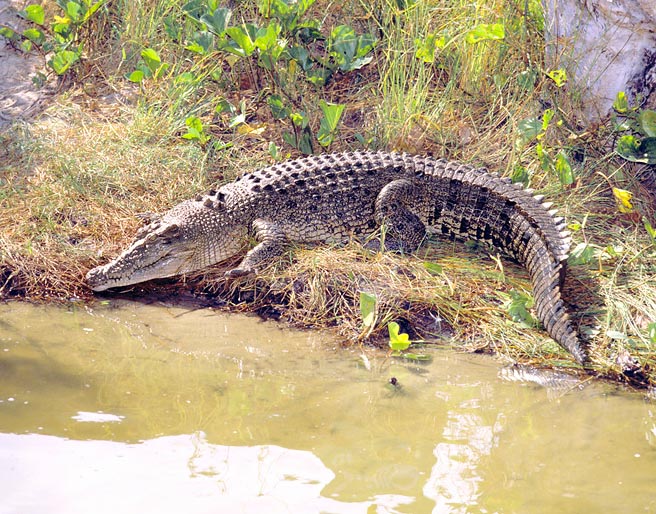
Females are smaller and usually lay 40-60 eggs © Giuseppe Mazza
The alimentary ecology of the saltwater crocodile is rather ample, the juveniles eat mainly aquatic arthropods (insects, crustaceans), molluscs, amphibians, and small fishes. Then while growing, they eat also reptilians (snakes, turtles), and larger fishes. Finally, adults eat also deer, buffaloes and wild hogs.
Morpho-physiology
As said at the beginning, the saltwater crocodile is the largest crocodile (only the Gharial can compete with him in terms of size) and, most generally, among the present reptilians. Leaving apart the legends (where they relate of specimens even 9 m long, please see about this the taxonomical text of the Crocodylia), the largest male specimens reach, at the maximum, the 6,5 m, perhaps the 7,0 m, but, as an average, they do not exceed the 5-6 m; the females are always smaller, 2,8-3,2 m as an average, 3,5 m at the maximum. The 5-6 m long males may exceed the weight of 1.000 kg, whilst the specimens of about 5 m weigh usually 500-600 kg.
This species of crocodile, has a very strong and heavy head, with a couple of crests departing from the ocular orbits and converge in the muzzle, and get more and more evident while the specimens are ageing; in the males, the rear of the muzzle becomes, with the time, more and more wrinkly, and from this comes the name of Crocodylus porosus.
The scales on the sides are more oval than those of other species, whilst on the belly they are rectangular and relatively small. The osteoderms are placed only on the back and on the nape, in small groups.
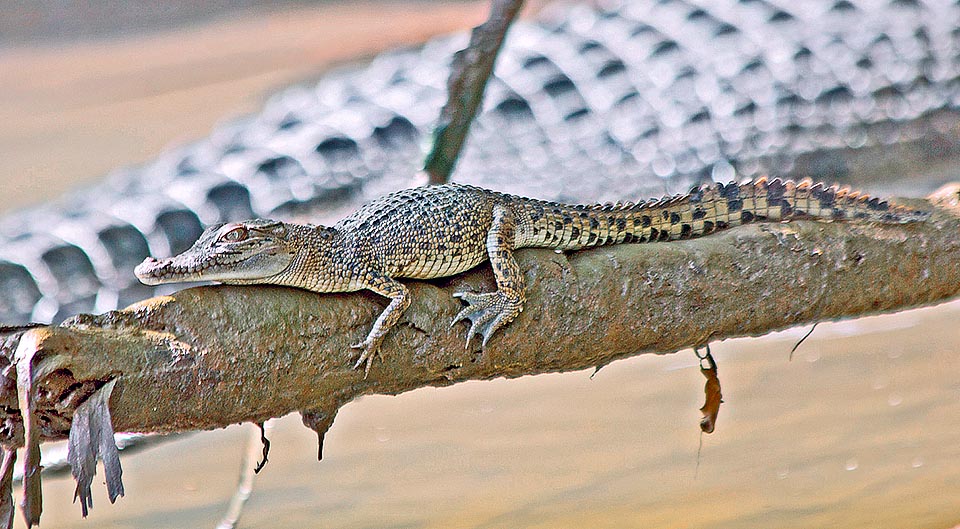
A fresh born baby and an adult in the mangroves. The nest is a hole made in the sand with buried vegetables that hold the humidity © Giorgio Venturini
An irregular black band is observed along the sides, not invading the belly; rarely may be seen two black dots on the scales of the belly, but this is an anomalous and rare condition. When attacking a prey, the saltwater crocodile, as, anyway, other species, in particular the Cuban crocodile (Crocodylus rhombifer), can utilize the tail for getting a forward thrust which takes it out from the water, suddenly, for seizing the prey. In some cases, it does true and real leaps. In the wild, this behaviour is more frequent n the Cuban crocodile, whilst, in captivity, both species do skilfully apply this technique. It has 64-68 teeth, of which 4 (more rarely 5) are premaxillar; 13-14 maxillary; 15 mandibular.
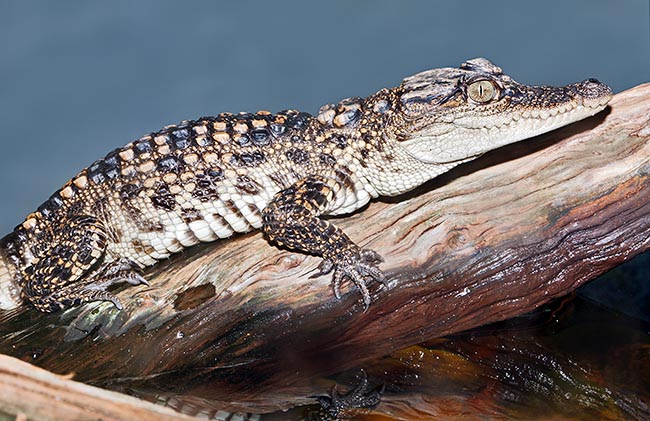
Despite maternal cares less than 1% of young become adult © Giuseppe Mazza
The coupling territories are usually along the sand banks of the rivers or of the streams. The females reach the sexual maturity when 2,2-2,5 m long (about 10-12 years of age), the males when about 3,2 m (about 16 years of age). The nest is built by the female. It consists n a hole filled up with vegetal material, such as branches, leaves, tendrils, grass and mud, where it immediately lays 40-60 eggs (even 25-90) and then buries it. They are built in elevated areas in order to avoid that they are swept away by the water of the rivers swollen rivers, between November and March, during the rain season, even there may be variations depending on the geographic area.
The closing of the nest is useful for mainly avoiding the dehydration of the eggs, by avoiding insolation phenomena and for reducing the risks of predation by varanids, pythons, jackals or other species of crocodiles, such as the Freshwater crocodile (Crocodylus johnsoni).
But the main causes of destruction of the nests remain the too high temperatures and the floodings. If the eggs are submitted to a too high dehydrating stress, the embryos will die; and some biologists have observed that the mothers repeatedly moist the nests when the temperatures increase. The incubation period is, as an average, of 80-90 days, but it varies in a manner which is inversely proportional to the local temperature. At 32 °C, the incubation lasts, in fact, 80 days, with cooler or lower temperatures it prolongs till 90 days. When the hatching comes, the mother is alerted by the synchronized cries of the young, who are about to exit. It reaches the nest, digs, and takes gently in the mouth the newborns, transporting them to the water and caring them.
The “Temperature dependant Offspring Sex Determination” (TSD) in this species has been particularly studied by the biologists, as it is important to know it exactly for being able to apply the reproduction programmes in captivity, where the eggs are incubated artificially.
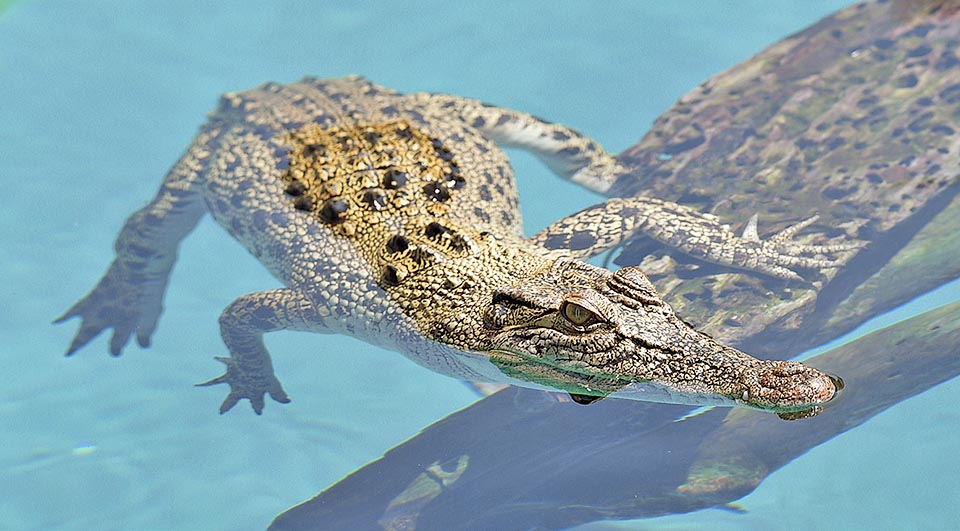
Sex depends on incubation temperature. If around 31,6 °C more males are born, but with few degrees more or less females prevail © Gianfranco Colombo
Less of the 1% of the hatched eggs will lead one day to sexually mature adults. Predators, floods, poaching and environmental pollution stand at the origin of the phenomenon, followed, during the growth, by stressing sociobiological factors and pressures, such as the presence of a dominant individual or of competitors limiting the development of the population.
→ To appreciate the biodiversity within the CROCODYLIA and find other species please click here.
→ For general information about CROCODYLIA please click here.
